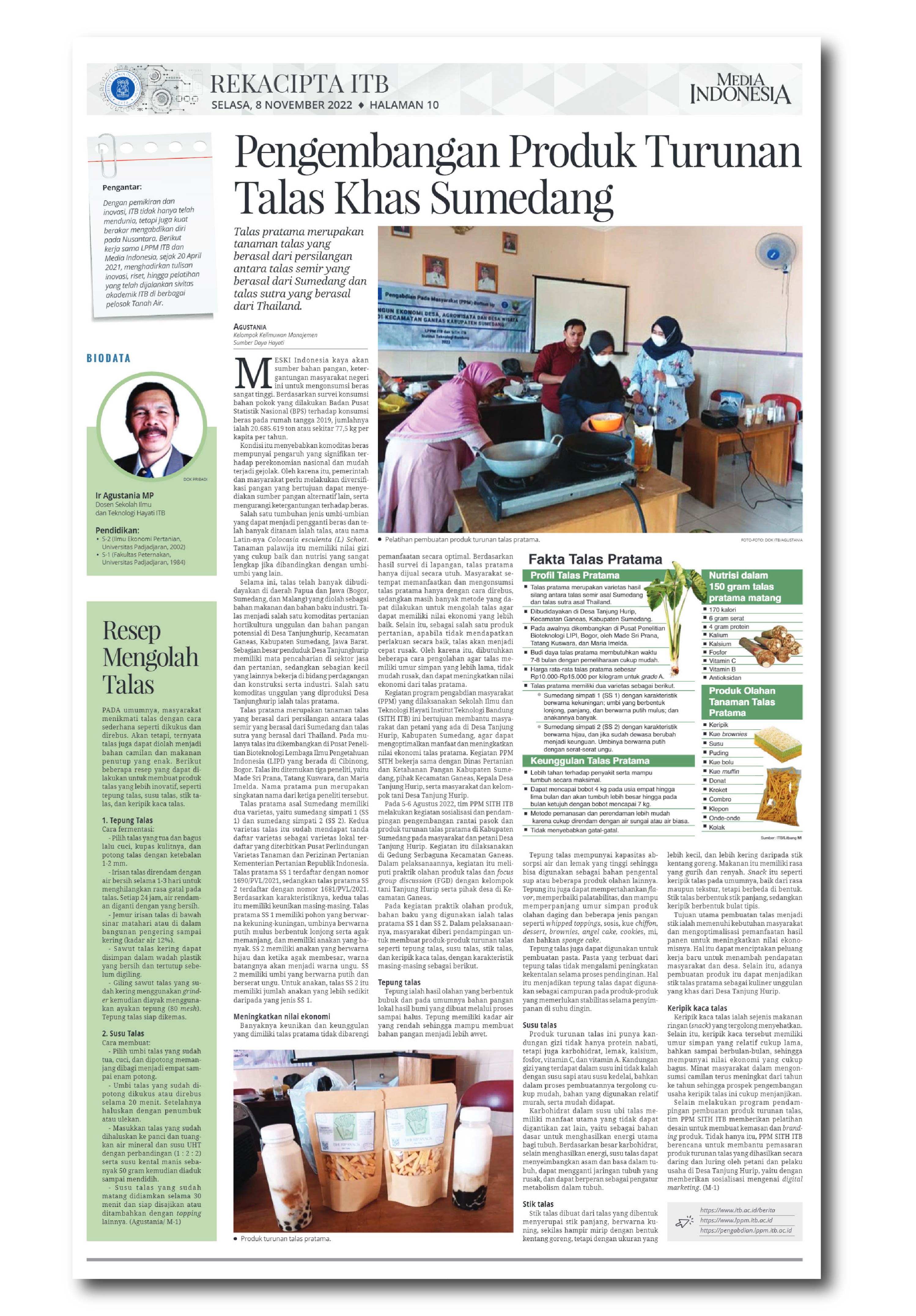ITB SITH’s Community Service on Taro Processing in Tanjunghurip Village, Sumedang
By Adi Permana
Editor Adi Permana
BANDUNG, itb.ac.id—Rice has been a staple food for Indonesians. Its commodity significantly influences the national economy. Thus, food diversification efforts are needed.
One alternative worth considering is the taro (Colocasia esculenta (L) Schott). Taro has a more complete nutritional value compared to other types of tubers and has been widely cultivated in Papua and Java regions as both sources of food and industrial raw materials. For instance, the people of Tanjunghurip Village, Ganeas District, Sumedang Regency, West Java make taro their leading horticultural agricultural commodity. The taro planted there is called the Pratama taro; its name is taken from the abbreviation of the names of three LIPI researchers who developed it, namely Made Sri Prana, Tatang Kuswara, and Maria Imelda.
The Pratama taro is the resulting product between the Semir taro from Sumedang and the Sutra taro from Thailand. The tubers have two varieties: SS 1 (Sumedang Simpati 1) and SS 2 (Sumedang Simpati 2). Both have been registered as local varieties at the Center for Plant Variety Protection and Agricultural Licensing, under the management of the Ministry of Agriculture of Indonesia.
Based on their characteristics, both varieties of the Pratama taro are unique in their own ways. The SS 1 variety has a yellowish tree with smooth, oblong white tubers and many saplings. On the other hand, the SS 2 variety is green with a purplish stem if enlarged. Its tubers are white with purple fibers and the number of saplings is less than the SS 1 variety.
Unfortunately, the advantages of the Pratama taro have not been utilized optimally. Based on field surveys, tubers are sold as a whole and usually consumed by boiling. As an agricultural product, the shelf life of the taro is very short without the appropriate treatment.
There are other methods that can be applied to process and increase its economic value. To develop such methods, a community service program organized by ITB SITH aims to help Tanjunghurip Village farmers in creating supply chains and more varieties of the taro’s derivative products. It was held on 5-6 August 5-6 2022 at the Ganeas Multipurpose Building with the support of the Agriculture and Food Security Service of Sumedang.
Local communities are invited to the hands-on training of processed taro products as well as FGD (Focus Group Discussion) with both farmers and villagers. They were accompanied in creating taro flour, milk, sticks, and chips.
Flour has a low moisture content and promotes longer shelf life. According to the ITB SITH lecturer Ir. Agustania, MP., who participated in the event, taro flour has a high capacity to absorb water and fat. Therefore, it can be used as a thickening agent for soup or other processed products. "The flour can also maintain flavor, improve palatability, and extend the shelf life of processed meat and cake products.”
Another derivative product that can be made from taro is milk. Taro milk is rich in vegetable proteins, carbohydrates, fats, calcium, phosphorus, vitamin C and vitamin A. The beneficial carbohydrates found in it act as the main energy-producing substance for the body, which cannot be replaced with other substances. Moreover, the carbohydrates can balance acids and bases in the body, regenerate damaged tissues, and regulate metabolism.
Taro sticks are made from taro that are cut lengthwise. With their yellow color, they resemble french fries and at first glance. They have a savory taste and crunchy texture. The main purpose of processing taro into sticks is to meet the needs of the community and optimize the use of crops. The hope is that new job opportunities will be created to increase the income of the community and village.
Finally, taro chips are another healthy snack created to have a long enough shelf life and a good economic value. People seemed to like the snack so the prospect for its development is promising.
Aside from conducting a mentoring program that provides guidance in making taro products, the community service team provides training on its packaging and branding design. They plan to help market these products online and offline by farmers and business proponents in Tanjunghurip Village through digital marketing.

*This article has been published in the ITB Engineering rubric of Media Indonesia. The full article can be read on https://pengabdian.lppm.itb.ac.id
Reporter: Sekar Dianwidi Bisowarno (Bioengineering, 2019)
Translator: Ruth Nathania (Environmental Engineering, 2019)

.jpg)
.jpg)
.jpg)
.jpg)
.png)



